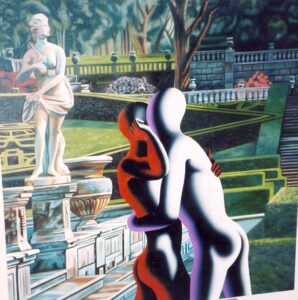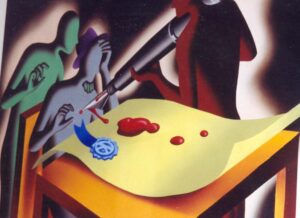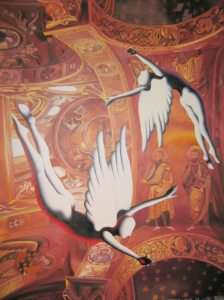 To many unfamiliar with the Kostabi World Art Factory, picture a giant art assembly line. Arriving at Kostabi World, I was instantly reminded of the Detroit factories creating a sellable product for the masses. My tale will hopefully expose a view of an insider and a naïve wonderment at a successful operation. The business continues today creating artistic canvases, prints & sculptures. On mentioning the Detroit factory, I have an insight as my southern USA family migrated to Detroit in the 1950’s to improve their financial prospects. When observing the Kostabi factory I immediately remember visiting my father at the stamping plant in which he worked. My father handled large flat pieces of moldable steel that a large press would form a beautiful fender to be installed on a 1965 Chrysler. The artisan craftsmen had found promising work in Detroit & of course Kostabi world found its platform in NYC. Not surprisingly, I found new immigrants including Russians, Poles & Puerto Ricans all pursuing their American art dream at Kostabi World. I was invited to visit and then employed in 1989 as a sub-contractor at Kostabi World’s Hell’s Kitchen location in NYC, a rather seedy warehouse area of Manhattan. Mark Kostabi held proprietorship over the three-floor building to crank out art. Many criticized the art factory business model in the 1980s & 1990s. I’m not that voice; however, the reality of someone profiting from claiming their ownership of your craftsmanship is conflicting ethically.
To many unfamiliar with the Kostabi World Art Factory, picture a giant art assembly line. Arriving at Kostabi World, I was instantly reminded of the Detroit factories creating a sellable product for the masses. My tale will hopefully expose a view of an insider and a naïve wonderment at a successful operation. The business continues today creating artistic canvases, prints & sculptures. On mentioning the Detroit factory, I have an insight as my southern USA family migrated to Detroit in the 1950’s to improve their financial prospects. When observing the Kostabi factory I immediately remember visiting my father at the stamping plant in which he worked. My father handled large flat pieces of moldable steel that a large press would form a beautiful fender to be installed on a 1965 Chrysler. The artisan craftsmen had found promising work in Detroit & of course Kostabi world found its platform in NYC. Not surprisingly, I found new immigrants including Russians, Poles & Puerto Ricans all pursuing their American art dream at Kostabi World. I was invited to visit and then employed in 1989 as a sub-contractor at Kostabi World’s Hell’s Kitchen location in NYC, a rather seedy warehouse area of Manhattan. Mark Kostabi held proprietorship over the three-floor building to crank out art. Many criticized the art factory business model in the 1980s & 1990s. I’m not that voice; however, the reality of someone profiting from claiming their ownership of your craftsmanship is conflicting ethically.






I had been chasing an art career for some time and it carried me to NYC in 1989. While working there at several billboard companies, I started putting in part- time and sometimes full-time hours at Kostabi World. My position was a highly-paid production artist. I was one of the few to continue on to secondary art market myself & also make a small living at it. Many other professionals have art assistants or apprentices. During my times in the various locations of Kostabi World, there were 15- 25 different staff member who had specialties. People would sketch the faceless figures with some cartoonish poses and then present to a committee of other artists for approval. The troubling aspect in this scenario is that the artist style and content could be perpetuated indefinitely without the original artist’s involvement or presence. The other ethical conundrum is a hand-painted artistic oil piece would be created by an anonymous artist but signed by a famous artist whom has not sweated over it. I also noted a strong direction towards the Italian art market change the studio focus and imagery. Some Christian ideas like angels were met with a good reception. This environment had quite talented artists like Clifford Lee and Roman Scott. Skilled painters like Ryszard Semko, Ron English and Claude Secarro moved on from Kostabi World to various levels of success . Most peasant painters were struggling to survive with NYC’s high cost of living, though most artists considered it a small cost to pay in chasing their art dreams. Some dissent in the factory system lingers even now. Art continues to add to the beauty of life’s experience. I’ve been blessed with my involvement in art at many levels.

